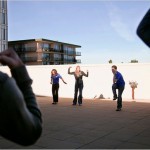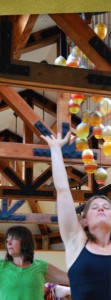Change Your Creative Thinking Through the Body

1. Which Lens to Look Through to Change?
You want to change your creative mind. More focus. More fire. More flexibility and creative thinking. But every time you try to change, you revert back to old patterns. How do you change? How do you get “to the bottom of things”?
A Freudian lens might say, “Go within to find out why you can’t change. Plunge into your psyche’s depths and neuroses to find the root cause and root story.” A New Age lens might say, “Imagine yourself changed, and soon you’ll attract everything to change you.” Or another soft lens might simply say, “You’re good enough. Stop trying to change yourself.” Which would be nice except the body will continue to change and the mind with it whether we will it to change or not. All three ways fall short. Scientists and sages alike show it so.
Maybe the way to change is more physical and less mystical than we care to hear.
The more-than-creative thinking training I’ve developed for a select group gets to the core – without the Freudian stories or mystical wishful thinking.
2. A Social Psychologist, a Neurologist, and a Cognitive Scientist Walk into a Gym….
This isn’t exactly a joke. Consider this:
The Social Psychologist: Take two college freshmen. Once excellent high school students, they each now lag academically. And emotionally they’re each a mess.
The first student thinks he’s the problem. He must be depressed. Stupid. Not trying hard enough. Maybe it has to do with when he was five-years-old and his parents divorced and he was left to fend for himself but never really adapted to that new situation well. Plus, his father never told him he was smart. Ah, The Story!
The second student is given information. She’s shown statistics of how successful high school students typically suffer their first year or two in college. It’s not just her. She gets testimonials from older students that college life can get better. She’s given strategies for studying differently. She’s shown how to change her environment so she can flourish.
The first student has a grand story but no plan to change his circumstances. The second student got Story Editing. A new frame. A little less sexy, story editing is one of the brilliant breakthroughs of social psychologist Timothy Wilson. Since the 1970s, Timothy Wilson’s research consistently shows how we make decisions on unconscious irrational impulses – although we consciously rationalize with elaborate explanations for our behavior.
And what influences the irrational impulses? Well, that’s challenging to account for in this limited space, but those factors include our environment and our physiology. Even our respiration.
The route to change might reside in the present physical world instead of in the past memory world.
The Neuroscientist: Fred “Rusty” Gage studies brains for a living at the Salk Institute and plays racquetball each week. The two things are connected. The 51-year-old professor of genetics focuses especially on how aging brains change for better and worse. And two factors that shape the brain positively stand out in his research: environment and exercise.
In 1999, talk of a middle-aged brain generating new cells or growing “synaptic connectors” could get a brain scientist branded as a quack and literally ostracized. Gage and a handful of other bold innovators in the gray matter world prevailed. Although Gage cannot yet explain exactly why, his research consistently and persuasively demonstrates that a middle-aged person who exercises can facilitate her brain cells’ growth.
The exercise needs to be regular, intentional, and somewhat repetitious.
The Cognitive Linguist and Cognitive Scientist: Mark Johnson and George Lakoff set Western science’s assumptions on its head in the 80s and 90s. Their first book Metaphors We Live By shows how we collectively inherit linguistic metaphorical categories that shape our perception of reality, love, relationship, argument, beauty, spirituality. The basis of those metaphors? Our mammalian bodies’ experience in the physical world.
Their second book Philosophy in the Flesh: How the Embodied Mind Challenges Western Science argues that Reason – that king of Western Enlightenment faculties – stems also from our physical experience and (in line with Wilson’s findings) is largely influenced by emotional and unconscious impulses.
Here’s the clincher statement for me when I read this book in 2000 (it was published in 1999, the year of Gage’s breakthroughs):
Conscious thought is the tip of an enormous iceberg. It is the rule of thumb among cognitive scientists that unconscious thought is 95 percent of all thought – and that may be a serious underestimate. Moreover, the 95 percent below the surface of conscious awareness shapes and structures all conscious thought. If the cognitive unconscious were not there doing this shaping, there could be no conscious thought.
95%?
(Recent resources: Sam McNerney gives a narrative of embodied cognition in November’s issue of Scientific American. And Gretchen Reynolds, a New York Times blogger, recently reviewed even more current science on exercise’s benefits to the brain.)
With apologies to each scientist for the above over-simplifications, the way these scientists converse with sages confirmed in part the method I developed in 2001 and has shaped the not-your-same-ol’-creative-thinking-exercises training I created in 2009. The science is sort of the 5% of what motivated me to create this training.
3. Your Mind is an Iceberg
Imagine your mind as a vast iceberg moving through an ocean. Most of us can only see about 5% of it, the part sticking out of the ocean. You know the 5% well. It’s that rational, analytical conscious mind you’re using to comprehend this sentence.
Call it Tip Mind.
And the other 95%? That 95%, submerged below the surface, shapes and influences the 5% tip. It can shape how flexibly you think, how quickly you come up with solutions, how persistent is your attitude to execute your idea, how focused is your attention, how readily you heed fleeting images and associations that could be the surprise breakthrough to a creative problem.
What makes up that 95%? Feelings and sensations. Emotions. Weird body things we don’t usually think about like your heart beat and breathing patterns and organ functions. Stray sensory input from the clatter in your office or the flash of the half-naked man with pink hair you saw roller-skating while on your commute (which wouldn’t be weird if you lived in Venice Beach instead of Iowa).
That stuff even influences your views on reality and truth and love and all that big-idea jazz that can lead to memorable, impact-ready stories and art and marketing (not to mention simply living a day artfully).
Yes. That 95% of your mind’s iceberg partially influences how you create, how productive you are, and what you create. Simple as that.
So if it’s submerged, you can’t access or alter it, right?
Not exactly. These pioneers in brain science (Fred Gage and others), social psychology (Timothy D. Wilson and positive psychologist leaders Martin Seligman, Mihaly Csikszentmihalyi, Jonathan Haidt, Dacher Keltner, and others), and neuropsychology (Daniel Siegel and others) are on the trail to helping us do so.
And certain sages have been practicing and sharing such tools for centuries.
4. Accessing More of the Other 95%
So, wouldn’t it be cool if as a creative or creative professional, you had the know-how to use an easy-to-apply yet profoundly effective system based on the best of the sages & the scientists & the creatives to help you
engage more of the 95%
on behalf of your creative ends?
Not to be too melodramatic, but, well, here’s the big note, here’s the call-out:
Enter Yoga As Muse.

It’s no panacea. It won’t make you a lavender-loving, “way-shanti,” bead-wearing peacenik who has lost his creative edge – although there’s nothing wrong with lavender and peace! (New York designer Christoph Niemann has yet to experience YOGA AS MUSE. You can have your YOGA AS MUSE and keep your edge, too.)
I don’t need to enumerate here the 77 Benefits of Yoga since this non-yoga affiliated resource NursingDegree.net has outlined the current science so beautifully.
YOGA AS MUSE, simply put, trains creatives, creative professionals, freelancers, and other audiences to become more aware of how that 95% of their creative minds work optimally.
I’m not exaggerating when I say this: YOGA AS MUSE’s easy-to-apply system of tools can ![]() increase your focus, heighten your imagination, sharpen your mental awareness, shift tired patterns of thinking and inaction, and stoke you to act upon fresh ideas. I experience it. I witness its effects countless times. The scientists keep corroborating in dense scientific cant what sages attested in esoteric aphorisms: These tools change the mind. And the brain.
increase your focus, heighten your imagination, sharpen your mental awareness, shift tired patterns of thinking and inaction, and stoke you to act upon fresh ideas. I experience it. I witness its effects countless times. The scientists keep corroborating in dense scientific cant what sages attested in esoteric aphorisms: These tools change the mind. And the brain.
Here is the break-through book that lays it all out: The Journey from the Center to the Page: Yoga Philosophies and Practices as Muse for Authentic Writing.
4. My Real Motivation – A Screwed-Up Life
I once was content to be a tight-necked, furrow-browed, heart-armored writer. Yoga screwed all that up. It messed up a lot of things I held true. “Accept your circumstances and make the most of your prison.” “Emotions are the bane of human existence.” “Love gets in the way of work.” “Misery makes me a better writer.” Little things like that. That was my story.
Yes, yoga screwed up my life in beautiful ways.
See you in the woods,
Jeffrey
Jeffrey Davis is a creativity consultant and writer in New York’s Mid-Hudson Valley. He thrives on helping creative professionals, practitioners, and teams pursue mastery of their work flow, mindset, and field.
WONDER FOR CREATIVES
Steal one of 4 spots left.
Mabel Dodge Luhan House, Taos, NM
March 11-16, 2012
YOGA AS MUSE & WONDER IN THE BAHAMAS
Bahamas Yoga Retreat Center
sampler course: Jan. 23-24, 2012
Yoga As Muse writing course:
January 26-30, 2012